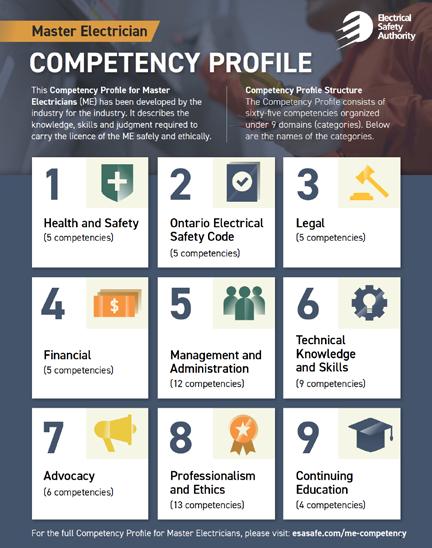
4 minute read
SAFELY POWERING TOMORROW
ESA’s journey towards becoming a modern regulator
Soussanna Karas, Director, Licensing and Training, Electrical Safety Authority

About ESA
Picture it – you purchased an electrical vehicle (EV). You are trying to be an environmentally responsible citizen making your contribution to the reduction of carbon emissions. As a next step, you go online to Kijiji or Craigslist and find an electrician who promises they can install an EV charger fast, and cheap. Without a second thought and without verifying whether they are licensed, they are hired. They come to your home and install the charger in your garage. In fact, they aren’t licensed. No permit for the work is obtained from the regulator and no inspection is conducted. In this situation, despite your best intentions, you have engaged with the under- ground economy and potentially put your new vehicle investment, your property and your family at risk of fire or worse.
The Electrical Safety Authority (ESA) regulates and promotes electrical safety in Ontario. ESA is mandated by the Ontario Government to implement and administer Part VIII of the Electricity Act and associated Regulations. ESA’s vision is an Ontario where people can live, work, and play safe from electrical harm.
Supporting the future of electrification in Ontario
One of the ESA’s primary functions is licensing and regulating Master Electricians (ME) and Licensed
Electrical Contractors (LEC) with the goal of enhancing electrical safety, and consumer protection. These licencees deliver electrical services to industry, businesses and homes across the province. They are also critical to enabling the transition to electrification, supporting net zero targets and the adoption of new technologies.
A few facts about ESA licensing framework In fiscal year 2023:
• There were approximately 25,000 active licence holders.
• We administered over 1,200 licensing exams.
• We handled close to 2,000 public complaints, and conducted almost 100 investigations which resulted in 150 charges being laid.
• We processed and issued 1,135 compliance actions and issued close to 1,500 licence suspension and revocation notices.
Licensing Strategy 2021-2025
Prior to becoming the Director of Licensing in 2020, I worked with a number of different regulators in the safety and consumer protection sectors. In close to 20 years of working in the regulatory space, I have worked with public institutions, professional associations, consumer advisory groups and other stakeholders who have crucial but diverse interests in the administration and enforcement of regulatory frameworks.
This broad experience has taught me to listen to, and appreciate, the many diverse perspectives that come to bear on the complex issues we deal with. It has brought a firm belief that to become a modern regulator, it is crucial to consult and collaborate with others to reach pragmatic solutions with beneficial impacts. This is why, when I began my mandate, the first order of business was to develop the first ever 5-year Licensing Strategy. ESA’s Licensing Strategy was developed in close collaboration with licence holders, professional associations, and the ESA advisory councils. What I heard during the engagement with the stakeholders is the desire to see the ESA as a partner in safety, engaging in open dialogue and collaboration on issues that are important to the licence holder community.
Competency Profile
Whether it is the installation of electric vehicle charging stations, the development of a local microgrid system or the upkeep of a large-scale transmission line, licensed electrical contractors and their skilled workforce are essential to powering Ontario’s ambitious electrification plans, especially as the need for new electricity supply grows. Recognizing this, and with advice from our advisory councils, ESA undertook the development of a comprehensive Competency Profile for Master Electricians, which was released earlier this year.
The Competency Profile describes the professional capabilities and best practices of an individual applying for, and holding, a Master Electrician licence. It doesn’t create new obligations, but supports compliance with the existing regulatory requirements.
The Competency Profile was first of its kind for electrical contractors. It naturally has an emphasis on electrical safety, but also highlights critical interconnected components like consumer protection, ethics, and diversity and inclusion, among other topics. It received great support during the development and consultation process. Crafted collaboratively, the Competency Profile is the result of extensive efforts by subject matter experts, industry representatives, and the invaluable feedback of 1,576 MEs who provided input through a survey. Through their dedication, 65 competencies have been created, spanning nine domains. These competencies encompass everything from technical knowledge and skills to health and safety, management, advocacy, and professionalism, ensuring a well-rounded foundation for every ME.
As the ESA takes this important step, we have heard from the licensed community that simply developing and posting the competencies is not enough. More guidance and support is required. Recognizing that lifelong learning is essential for maintaining lifelong safety, ESA created the award-winning1 Competent Designated Master Electrician Module which is available to all licencees free of charge. By encouraging continuous professional development, the ESA supports licence holders in staying abreast of the latest advancements in the field, promoting a culture of safety, consumer protection and excellence.

Sharing regulatory insights
As we continue in our journey of listening, engaging and partnering with the licensed community with the goal of improving consumer protection and electrical safety, I wanted to pose a question to the broad regulatory community.
For those of you that have developed and launched your own competency profiles (or equivalents), what does successful implementation look like at your organization? How do you measure adoption of these competencies and change in behaviour? How do you continue to engage with your stakeholders to ensure you have living framework that reflects the evolution of the workforce of tomorrow and the regulator’s role in supporting this evolution? You can reach me at Soussanna.Karas@ electricalsafety.on.ca. I would be very grateful for your insight, feedback, and continued collaboration.
1 This Module was recognized with the Gold Hermes Creative Award in 2023.
The Registrar magazine invites regulatory bodies to contribute news, updates, and other information in their own words. If you are interested in spotlighting your regulatory body, contact The Registrar magazine.
The opinions expressed in this article are those of the organization and its contributors.







